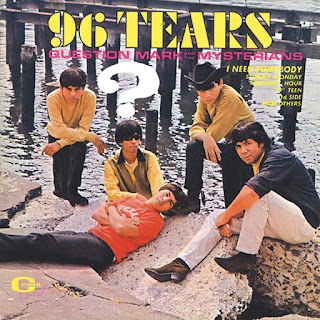One Hit Wonder: ? and the Mysterians (1966)
 96 Tears
96 Tears
Single by ? and the Mysterians
from the album 96 Tears
B-side: "Midnight Hour"
Recorded: 1966
Released: August 1966
The song "96 Tears" by the American garage rock band? and the Mysterians was released in August 1966. It was number 1 on the U. S. Billboard Hot 100 in October. Billboard ranked the record number 5 for that year.
It's number 213 on the Rolling Stone list of the 500 Greatest Songs of All Time, and number 9 on their Readers Pick the Top 10 One-Hit Wonders of All Time. VH1 numbers it 15 of their 100 Greatest One-Hit Wonders. It's also on the Rock and Roll Hall of Fame's list of 500 Songs That Shaped Rock.
Recording
This song was written by "?" the band's frontman, who wanted to be anonymous. It was recorded in Bay City, Michigan. The mystery helped market the group, who wore dark glasses to add to the intrigue. Since mystery has always been a staple of their act, it's hard to know which stories about the group are factual. When they recorded this song, they were a five-piece band whose families migrated from Mexico and Texas to work in the Saginaw Valley in Michigan.
The band recorded the single for the small Pa-Go-Go label, owned by Lilly Gonzalez, in the personal studio in her basement. Question Mark and the Mysterians guitarist Robert "Bobby" Balderrama was 15, and organist Frank "Frankie" Rodriguez was 14 when they recorded it. Balderrama recalled. "I remember we went in there and were using Fender amplifiers and having problems with them. Tubes were hanging upside down, and we picked up a lot of noise, so we had to turn the amplifiers upside down."
The organ riff on this song defined the sound of that era. The band's keyboard player, Frank Rodriguez, used a Vox Continental on "96 Tears." Don Henley used a Vox to get a retro sound on his hit single "Dirty Laundry."
Music Charts
The band then had the Texas-based Pa-Go-Go Records press 500 copies to distribute to the DJs in southern Michigan. The song became the most requested record on WTAC Flint and CKLW out of Windsor, Canada, which went into Detroit. Cameo Records picked up the record after one of its staffers heard it on CKLW. After an October 1, 1966, performance on Dick Clark's American Bandstand, the song went to the top of the charts on October 29.
Garage Bands
The song appeared on the band's album 96 Tears. One of the first garage band hits, it's credited as starting the punk rock movement. Balderrama noted: "A lot of the punk bands from the '70s and '80s … always looked to us as an influence, and I thank them." One such group is the British punk band, The Stranglers.





Comments
Post a Comment